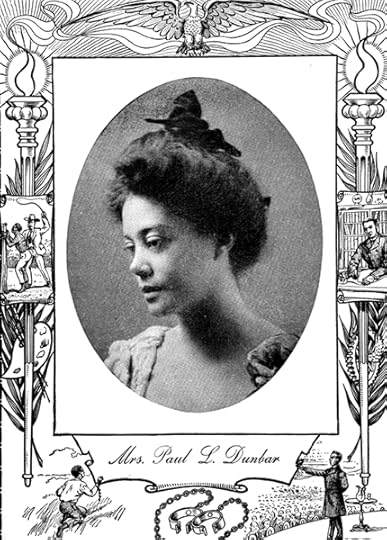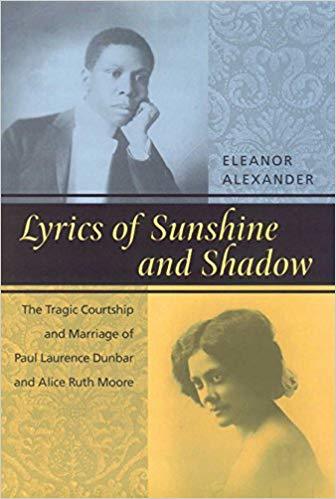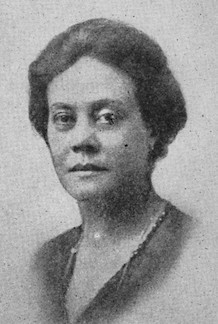Alice Dunbar-Nelson
Alice Dunbar-Nelson (July 19, 1875 – September 18, 1935) was an American poet, essayist, short story writer, journalist, activist, and teacher. Sometimes known as Alice Moore Dunbar-Nelson, she advocated for the rights of women and African-Americans and was considered one of the premier poets of the Harlem Renaissance era.
Born Alice Ruth Moore in New Orleans, she was of Creole heritage, blending African-American, Creole, European, and Native American roots. Her mixed ancestry would give her a broad perspective on race as she matured, while she personally struggled with the issue of belonging.
Her father, Joseph Moore, a freed slave, was a merchant marine, and her mother, Patrica Wright, was a seamstress. Her family was considered middle class, so she was able to benefit from growing up in a diverse city, fairly free from the constraints of Jim Crow laws.
Alice graduated from Straight University (now Dillard University) in 1892. This was notable for its time, as less than 1% of all Americans were college graduates, let alone women and people of color. Her first job was as a teacher in New Orleans’ public school system. Subsequently, she worked in a variety of occupations, most notably in journalism as an editor and columnist.
Early publications
Violets and Other Tales, her first book, was a collection of poetry, essays, and short stories. Just twenty at the time of its publication in 1895, Alice’s writings were already flavored with feminism and social justice.
The noted poet Paul Laurence Dunbar began writing to Alice after seeing a photo of her with a poem she had published in an issue of Monthly Review in 1897. They conducted their relationship mainly via correspondence and married secretly in 1898 in New York City. The couple then moved to Washington, D.C.
Critics have noted the uneven quality of the writings, though some of the pieces showed her promise as a writer. She wasn’t easy to pigeonhole, which made publishing her work a challenge. Sheila Smith McCoy wrote:
Dunbar-Nelson continued to write and, in 1899, published The Goodness of St. Rocque and Other Stories, which included a revision of “Titee” (one with a happier ending), “Little Miss Sophie,” and “A Carnival Jangle.” Aside from the ending of “Titee,” the revisions of these stories heralded the problems that she faced with later manuscripts.
Publishers, eager for dialect stories such as those that made Paul Laurence Dunbar famous, opted for versions of these stories in which the characters spoke with pronounced creole dialects. Dunbar-Nelson’s published fiction dealt exclusively with creole and anglicized characters; difference was characterized not in terms of race, but ethnicity.
Many of her manuscripts and typescripts, both short stories and dramas, were rejected when Dunbar-Nelson explored the themes of racism, the color line, and oppression. This, coupled with the fact that Violets and St. Rocque, published so early in her career, were, until recently, the only published collections of her work, have made it difficult for both readers and critics to access Dunbar-Nelson’s work.
. . . . . . . . .

A selection of Alice Dunbar-Nelson’s poetry
. . . . . . . . .
What began as a romantic liaison with Paul Dunbar soon turned into a disastrous marriage. Dunbar was in poor health, an alcoholic, and suffered from a form of tuberculosis. He physically abused Alice and nearly beat her to death in 1902, after which she left him. Alice was bisexual, and it has been posited by Lillian Fadiman, author of Odd Girls and Twilight Lovers: A History of Lesbian Life in Twentieth-Century America, among others, that Dunbar was angered by her affairs.
After their parting, Alice moved to Wilmington, Delaware. She never saw Paul again, and despite the acrimonious ending, never formally divorced him and continued to publish under the name Alice Dunbar. There, she resumed her career in education, teaching in a high school as well as at the State College for Colored Students (Delaware State College) and Howard University. Paul Dunbar died in 1906.
Alice married Henry Arthur Callis, a physician, in 1910. This marriage, too, was short-lived. In 1916, she married Robert J. Nelson, a civil rights activist, who may have been the catalyst, at least in part, for her increasing involvement with social justice issues, primarily racial equality and women’s rights. This marriage endured, and Alice continued to have intimate relationships with women as well.
Alice, like her husband, became politically active, and in the early 1920s, campaigned for the Dyer Anti-Lynching Bill (which was ultimately unsuccessful, because of a racist congress). She also helped establish several schools for African-American girls.
. . . . . . . . .

Books by and about Alice Dunbar-Nelson on Amazon
. . . . . . . . .
While teaching in Wilmington, Alice continued to publish poetry and essays and served as an editor for African-American periodicals and anthologies. Her poems were widely published in The Crisis (NAACP), Ebony, Topaz, and Opportunity (Urban League) in the late ‘teens and through the 1920s.
This was a remarkably productive period. Alice was right in the thick of the creative flowering of the Harlem Renaissance era, though she didn’t live in New York City, where much of the action was taking place.
Alice was also committed to journalism in the 1920s, contributing highly regarded columns, articles, and essays to several prominent Black newspapers as well as magazines and academic journals. She was also, during this time, a sought-after lecturer and speaker. While she achieved an unusual degree of success in journalism, it was no easy path for a woman of color, and she wrote honestly the obstacles she faced.
In her searingly honest essays in which she also recounted the challenges of growing up mixed-race in Louisiana. She explored these themes along with the varied and complex issues faced by women of color in both her essays and in her body of short stories. In “Brass Ankles Speaks,” for example, she wrote about multiracial people bearing “the hatred of their own and the prejudice of the white race.”
As her reputation grew, she continued to explore sexism, racism, work, sexuality, and family in the various genres in which she wrote.
. . . . . . . . .

. . . . . . . . .
Gloria T. Hull, editor of The Works of Alice Dunbar-Nelson (Oxford University Press, 1988), wrote of her subject:
“One senses in practically everything that Alice Dunbar-Nelson wrote a driving desire to pull together the multiple strands of her complex personality and poetics …
What she was able to achieve in prose outweighs her poetic accomplishments although, ironically, being taken as a poet has helped immensely to keep her reputation alive. Dunbar-Nelson was not driven to write poems and did not focus on the genre …
By and large, Dunbar-Nelson’s poetry is what it appears to be—competent treatments of conventional lyric themes in traditional forms and styles. Her signature poem, “Violets,” is the apogee of this type. A few others stand out for various reasons. “I Sit and Sew,” wherein a woman chafes at her domestic role during wartime, seems feminist in spirit.
“You! Inez!” appears to be a rare eruption in verse of Dunbar-Nelson’s lesbian feelings. “Communion” and “Music” were probably (like “Violets”) selections in a no longer extant Dream Book commemorating her illicit affair with Emmett J. Scott, Jr. “To Madame Curie” and “Cano—I Sing” are strikingly well-executed … “The Proletariat Speaks” reminds one of her consciousness about difference and class contrasts.
Dunbar-Nelson, in her way, helped to create a black short-story tradition for a reading public conditioned to expect only plantation and minstrel stereotypes. Her strategy for escaping these odious expectations was to eschew black characters and culture and to write, instead, charming Creole sketches that solidified her in the then-popular, ‘female-suitable’ local color mode.”
Later in life, Alice moved to Philadelphia with her husband when he went to work for the Pennsylvania Athletic Commission. Her health began to decline, and she died in a Philadelphia hospital on September 18, 1935, at the age of sixty.
More about Alice Dunbar-NelsonOn this site
A Selection of Poems by Alice Dunbar-NelsonMajor works
Violets and Other Tales (1895)The Goodness of St. Rocque and Other Stories (1899)Masterpieces of Negro Eloquence (1914; in the capacity of editor)Mine Eyes Have Seen, (1918; one-act play)“From a Woman’s Point of View” (later, ”Une Femme Dit”; column for the Pittsburgh Courier , 1926)“I Sit and I Sew,” “Snow in October,” and “Sonnet,” in Caroling Dusk:An Anthology of Verse by Negro Poets (1927)“As in a Looking Glass” (1926–1930; column for Washington Eagle newspaper)”So It Seems to Alice Dunbar-Nelson” (1930; column for the Pittsburgh Courier)
Biographies and critical anthologies
Give Us Each Day: The Diary of Alice Dunbar-Nelson, Gloria T. Hull, editor (1984)The Works of Alice Dunbar-Nelson, Gloria T. Hull, editor (1988)More information and sources
Wikipedia Poetry Foundation Modern American Poetry Alice Ruth Moore Dunbar-Nelson on BlackPast Biography of Alice Dunbar-Nelson on ThoughtCo.. . . . . . . . . .
*This post contains affiliate links. If the product is purchased by linking through, Literary Ladies Guide receives a modest commission, which helps maintain our site and helps it to continue growing!
The post Alice Dunbar-Nelson appeared first on Literary Ladies Guide.



